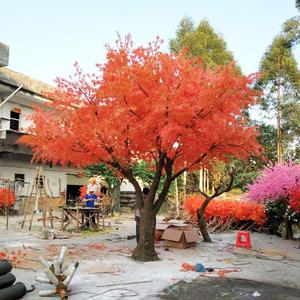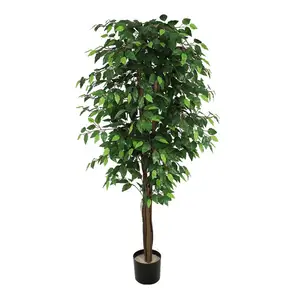(6772 products available)

































































































































































































































Artificial trees are manufactured to give a naturalistic look and feel. They come in different forms and types. Some of the commonly known artificial trees made by manufacturers are as follows:
Artificial Christmas Trees
Christmas tree artificial decorations are evergreen trees like fir, pine, or spruce. They are manufactured for people to use during Christmas. Such Christmas trees are designed to resemble real trees and often come with decorations like lights, ornaments, and tinsel. They vary in size, color, and style and offer a convenient, reusable, and low-maintenance alternative to natural Christmas trees.
Artificial Palm Trees
Artificial palm trees are created to mimic real palm trees. They are designed for homes, offices, and other places where people want to create a tropical atmosphere. These artificial trees come in many sizes and varieties, including Areca, Date, Coconut, Fan Palm, and Potted Palm. They are made from materials like plastic and silk, with realistic-looking trunks and fronds.
Artificial Bamboo Trees
Artificial bamboo trees are manufactured to portray the real ones. They are designed for people who want to enjoy the beauty of bamboo without the maintenance of live plants. Some common types of artificial bamboos are Giant, Lucky, and Potted. They are made from plastic and other materials, featuring detailed stems and leaves to give a natural look.
Artificial Fruit Trees
Fruit artificial trees are designed to mimic natural fruit-bearing trees. They are made for decorative purposes and don’t produce real fruit. Some common types are Apple, Lemon, Orange, Cherry, and Peach trees. They are made from materials like plastic and silk, featuring detailed leaves and blossoms.
Artificial Deciduous Trees
Deciduous artificial trees are created to mimic real deciduous trees. They are usually manufactured for educational purposes, such as tree models, and can be used in gardens, parks, and other outdoor places. Some common types of artificial deciduous trees include Oak, Maple, Birch, Elm, and Ash. They are made from durable materials like fiberglass and plastic.
Artificial trees are carefully made to look real and serve specific needs. Designers study natural trees to copy their shape, color, and texture accurately. This involves selecting the right materials, like durable fabrics or plastics, to create a convincing bark and leaf appearance. The process begins with a strong frame, often metal or PVC, which gives the tree stability. Designers then attach branches and foliage to this frame, ensuring that everything is securely fastened yet flexible enough to create a natural look. The final step involves adding details such as flowers, fruit, and even lighting elements to enhance the tree's realism and functionality.
Materials
Artificial trees are primarily made using UV-protected polyethylene (PE) and polyvinyl chloride (PVC) materials. These are mixed with steel and iron to make the structure more robust. The leaves and branches are made using flame-retardant polyester material. These materials are chosen for their ability to resist weather, look realistic, and ensure the tree can be used for a long time.
Coloring Techniques
The coloring on artificial trees is done using a two-step coloring process. First, the branches and trunks are painted with a base color. After that, a secondary spray is applied to add depth to the texture. The leaves are dyed individually to ensure they have a natural look.
Construction Techniques
Artificial trees use a modular construction technique. They build them in sections or modules to make the assembly and disassembly easier. Each module is made separately and then connected to the central trunk. This technique makes transportation and installation easier, especially for big trees.
Lighting Options
Many artificial trees come with built-in lighting options. These are usually LED lights that can be placed in different parts of the tree. Some designs have remote-controlled lights that can change colors and patterns, adding to the beauty of the artificial tree at night.
Customization Options
Artificial tree manufacturers offer a lot of customization options. Customers can choose the tree's height, color, and specific branch and leaf features. Some companies also provide custom-made trees designed from the pictures and specifications given by the customers.
Artificial trees have versatility and practicality, serving many industries and commercial spaces. They are a great option for businesses with limited resources or those that want to beautify their space without the maintenance required by real trees.
Retail stores
Retailers use faux trees to create eye-catching product displays and to define different shopping sections. Artificial birch trees or palm trees can be used in stores as decorative accents to make the environment more welcoming and to entice customers to buy.
Restaurants and cafes
Food places use faux trees to create an attractive ambiance, especially for outdoor dining areas or themed interiors. Faux cherry blossom trees are used in Japanese restaurants while fake olive trees can be used in Italian restaurants to create a rustic feel.
Office spaces
Companies add fake plants and trees in lobbies, break rooms, or near windows to improve the look of the office and make it more pleasant. This is especially useful in places with no natural light where real plants may find it hard to survive.
Hotels and resorts
Artificial trees are used in hotel lobbies, pool areas, and garden spaces to create a visually attractive and comfortable environment. This enhances guests' experience while reducing the cost and effort needed to maintain real landscaping.
Event planning and exhibitions
Faux plants and trees are used by event organizers to create themed settings for weddings, parties, and corporate events. They are also used in trade shows and exhibitions to make attractive displays that draw visitors to booths.
Film and television sets
Production designers use fake trees to create backgrounds for scenes in movies, TV shows, and commercials. This helps to build a realistic environment without the logistical challenges of using real plants.
Museums and educational facilities
Museums use artificial trees to create interactive exhibits and themed dioramas. Fake oak trees can be used in natural history displays while palm trees can be used in tropical ecosystems to educate visitors about different habitats.
Healthcare facilities
Hospitals and clinics use artificial trees to create a calming environment for patients and visitors. This reduces stress levels in places where people are often anxious due to health issues.
Opting for the right artificial tree involves considering a range of factors. They include the tree's intended purpose, the area it will occupy, maintenance requirements, and personal style preferences. Here are some key points to consider when choosing an artificial tree:
Purpose and placement:
Determine the primary purpose of the artificial tree. Is it meant to enhance interior decor, create outdoor focal points, or serve as event decorations? Consider where it will be placed. The placement will determine the size, style, and lighting conditions the tree will mimic.
Quality and realism:
Choose artificial tree manufacturers that have realistic-looking artificial trees. Check the details, color variation, and texture of the leaves, branches, and trunk. Look for trees made from durable materials. They should have UV protection for outdoor use.
Size and scale:
Consider the available space. Choose an artificial tree that fits without overwhelming the area. Measure the height, width, and depth of the space. Consider the tree's size and ensure it is proportionate.
Maintenance:
Consider the maintenance required for the artificial tree. Choose trees with removable or washable leaves. They will be easier to maintain. Check if they need regular fluffing or repositioning to maintain their appearance.
Customization options:
Explore customization options. Some artificial tree manufacturers allow customers to customize tree height, pot style, and foliage density. Customization can help the tree better fit specific needs and preferences.
Safety features:
Look for safety features like fire-resistant materials. They are important for artificial trees used in public spaces or events. Choose trees with stable bases. They will prevent tipping or accidents.
Cost and warranty:
Consider the cost of the artificial tree. Don't compromise on quality for a lower price. Check the warranty. A good warranty can indicate the manufacturer's confidence in the product's quality and durability.
Q1: Do artificial trees look realistic?
A1: Yes, artificial trees are crafted with great attention to detail using high-quality materials. They have lifelike bark textures, leaf colors, and growth patterns. Good lighting and occasional maintenance, like leaf dusting, enhance their realism.
Q2: Are artificial trees a fire hazard?
A2: Most artificial trees are made from fire-retardant materials, which help reduce the risk of fire. However, it's essential to position them away from heat sources and follow safety guidelines. Check local regulations and tree safety standards for artificial tree supply info.
Q3: Can artificial trees be used outdoors?
A3: Artificial trees made for outdoor use are UV-protected to resist fading and withstand weather elements. They are usually more robust and durable. Ensure the tree's base is secure or anchored for outdoor placement.
Q4: How long do artificial trees last?
A4: Artificial trees can last many years, even decades, with proper care. Outdoor trees or those exposed to sunlight and harsh conditions may fade faster. Regular cleaning and occasional rotation can extend their lifespan.
Q5: Do artificial trees have a smell?
A5: New artificial trees may have a slight plastic or chemical odor. Unpack them in a well-ventilated area and let them sit for a few hours until the smell dissipates. Avoid using strong fragrances to mask the smell, as they can damage the tree's materials.
The web search volume for the keyword "artificial trees manufacturers" has shown notable fluctuations over the past year, with an average monthly web search volume of 50. Over the last twelve months, the web search volume peaked significantly in October 2024 with 170 web searches, reflecting a 40% increase year-over-year and a 75% increase in the past three months.
Analyzing the monthly data, the web search volume for "artificial trees manufacturers" generally remains stable at around 50 web searches, except for October 2024 when it surged dramatically. This spike stands out as an anomaly in an otherwise steady pattern. The months following October show a decrease, with November 2024 recording 70 web searches and December 2023 at 50 web searches, indicating a return to the keyword's average web search volume.
The trend for "artificial trees manufacturers" suggests seasonal variations, with the peak in October possibly linked to increased demand for artificial trees around the Halloween and early winter holiday seasons. The subsequent decline in web searches post-October could be attributed to a decrease in consumer interest or completion of seasonal purchasing cycles. This keyword's web search volume pattern underscores the importance of timing and seasonal consumer behavior in the home and garden category.